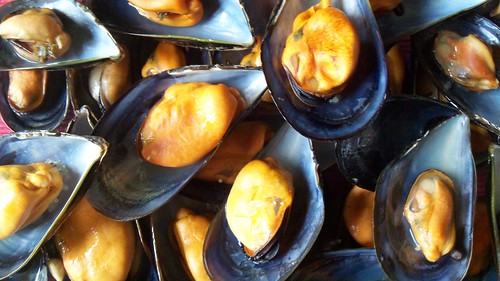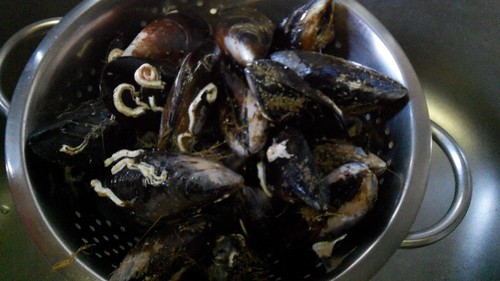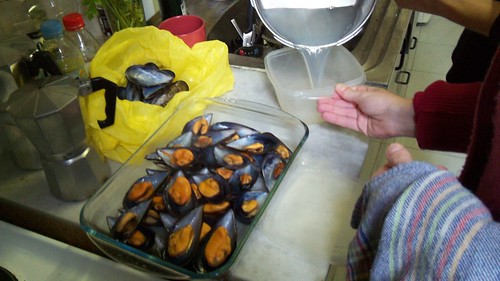...they are from Galicia, a heaven of molluscs and
crustaceans! Look on a map and you’ll understand why. A coastline more jagged
than a Stegosaurus, pounded by the fierce Atlantic, and harbouring an abundance
of estuaries that are perfect for growing mussels (mejillones). I’m lucky to
have made two very good Galician friends, Raquel and Sandra. Raquel hails from A Coruña, a city bracing the
mighty ocean, and naturally she has pangs for a taste of home, so once a week
we head to the market, put a euro in each and buy a fix of mussels. In truth I
used to be a bit scared of the fishmonger, it’s not the smell, it’s the fear of
being busted as a novice. Thankfully I’ve only experienced the opposite,
traders offering advice on recipes and rounding prices down.
So once you have a
bag of rugged mussels you need to clean and sort them, a job that is
surprisingly enjoyable. There is something a bit primitive about it, knife in
hand, gnarly shells, it’s all a bit survivor stylie. I got carried away scratching off every little mark, but there is no need I’m told,
just remove the beard (the tug of hair that keeps them attached to ropes/rocks
when growing).
When cleaned and checked they are the incredibly simple to cook.
Put them in a saucepan with a lid over a medium heat and just add the tiniest amount of water. The
vapour, not the water cooks them (unlike for example pasta), and they have the
most brilliant natural flavour and produce their very own cooking liquid. Once
all the shells have opened, drain, and save the liquid (this will do ever so
nicely as a stock for cooking rice another day).
Then as quick as you can set to removing one half of each
shell and lay them down on their backs over a dish. As you go, pour over a
little of the cooking liquid and a fresh squeeze of lemon, keeping them hot and
flavoursome. I rate this way of serving them, as you get to see the delicate
pearly inner shell which acts a nifty natural spoon, making them quick and easy to
eat.
Don’t get me wrong I am a huge fan of Moules Frites, with wine, with cider,
but if you can get your hands of Galician mussels I don’t think they need any
help, they are divinely smooth, lip smackingly tasty and ever so good for you.
Fork notes:
- Galician mussels are much bigger than their Mediterranean counterparts, the stirring Atlantic delivers more nutrients and enables them to grow larger. Though Clochinas from the east coast of Spain, harvested in Spring are another delicacy altogether and I look forward to eating them soon.
- Mussels are alive and they should close when touched or submerged in water, it’s their defense system, so if they don’t react, they could have died, or even worse, have been dead for a few days. Not worth risking it, we say bin those that won’t close when aggressed.
- They are a good source of zinc, zinc is good for the immune system, hurroo hurrah.
- The estuaries where they grow are called rias in Spanish and las bateas are the wood and rope structures that they grow from.
- Great for a starter but we like to eat them with a hefty salad and some bread for lunch.






No hay comentarios:
Publicar un comentario